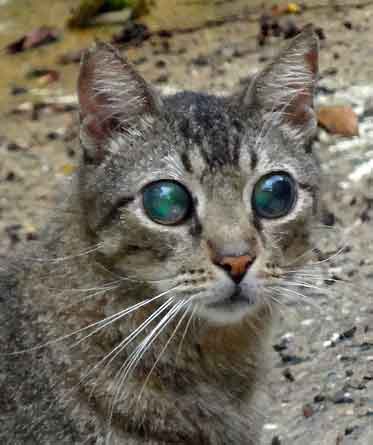
Notice: this article is in two parts to speed up page load times. Google likes that. At the base of the first section is a link to the second section.
Introduction
Feline eye disease – Here’s a long and comprehensive list. The first thing to do is to define the phrase “disease” in the search term (another search term is “cat health eye” by the way). It is easy to acquire a misconception with regard to terminology. The word “disease” can be used in a very wide sense. Essentially it means an abnormal condition that exists in an organism (meaning in this instance, a cat) that affects in a negative manner the normal working of the body. The negative impact can mean the death of the organism.
Sometimes we limit the term “disease” to mean infectious diseases (or at least I do). An infectious disease is one in which the normal working of the body is affected negatively by the presence of a pathogenic microbial agent, which is a very small object that causes disease. A well known example would be a virus. An individual viral particle is a minute object (sub-microscopic) that consists of DNA or RNA (genetic material) coated by a protein shell and which has to “live” inside a cell of the host, where it reproduces. Its presence kills the cell. When this happens a lot the host organism (in this case the cat) suffers with symptoms of illness.
Cat’s eyes are a very important sense for the cat and they are adapted to stalking and hunting particularly at dawn and dusk (crepuscular activity). They are large. If our eyes were the same size as a cats in proportion to our body they would be 8 inches across (src: Cat Owner’s Home Veterinary Handbook by Drs Carlson and Giffin). They have two readily apparent differences to ours (a) a mirror like layer of cells behind the retina at the rear of eye, which reflects light back to enhance the image in dark conditions and (b) an extra eyelid that can be seen sometimes and which serves to protect the eye when walking through brush and tall grass, for example, and to keep the eye clean. Feline eye disease therefore has a major impact on their lives. A cat sees slightly differently to people – see a comparison.
Note: A number of these diseases and conditions are painful to very painful (scratched cornea for example) and therefore a cat owner should seek prompt veterinary care.
Returning to feline eye disease in the widest sense; here is a highly summarized list. It is is meant to provide pointers for non-qualified people, no more:
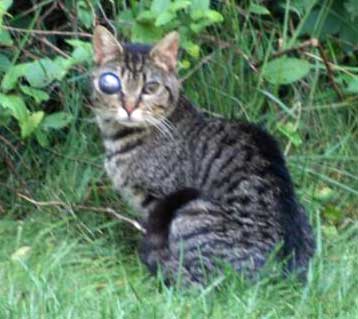
1. The eyes bulges from the eye socket (bulging eye) – several possible causes include (a) a blow to the eye fracturing the bones around the eye resulting in a build up of blood/fluid behind the eye forcing the eye forwards, (b) sinus infections spreading to the eye (c) a growth, malignant or not, behind the eyeball forcing it outwards and (d) “hard eye” – glaucoma (see below). But also see caption to image above.
Update: another example of feline glaucoma:
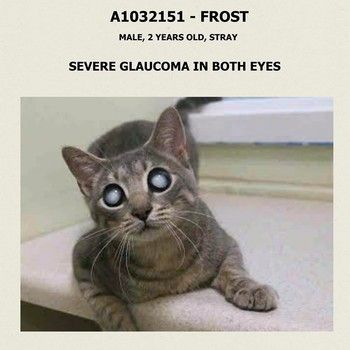
2.The eye sinks into the eye socket (sunken eye) – causes (a) dehydration and rapid weight loss (b) eye retractor muscle in spasm, which can be due to a tetanus infection or corneal injury (c) damage to nerve in the neck of the cat due to a neck injury for example (d) severe injury.
3. Jerky eye movements – indicates a problem with the inner ear.
4. Cross eye – Siamese cats commonly suffer from this feline eye disease and it is an inherited (genetic) condition. Other causes are (a) muscle paralysis (b) brain tumor (c) nerve injury. The classic Siamese cat squint does not affect bipolar eyesight. Inherited reason why Siamese are cross-eyed.
5. Inflammation of the eyelids – caused by (a) fighting leading to an infection, which in turn leads to scratching and more damage (b) mange mites (c) ringworm infection.
6. Foreign bodies – seeds or wheat (during harvesting) are one example. Causes discomfort and watering.
7. Sudden swelling – a feline eye disease caused by an allergic reaction from insect bites, allergens in food and/or drugs.
Photo above – I’m glad he made it. Cars are horrible for cats. Cat enclosures can be an answer or cat strollers! – photo by Fahara
8. Eye lash irritation – Eyelashes although rare for cats can turn inwards causing irritation.
9. Rolled in eyelid – (a) can be inherited in Persian cats and (b) in any cat due to conjunctivitis or a lacerated eyelid. Also thought to be a disease affecting the Bengal cat. Called Entropion. Very uncomfortable. Affects people as well.
10. Rolled out lower eyelid exposing eye to irritants – the feline eye disease is caused by (a) birth defect (b) badly healed cut of the lower lid.
11. Cancer of the eyelid


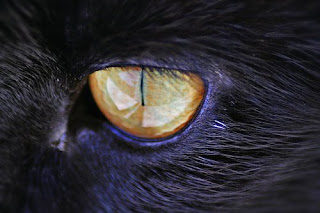
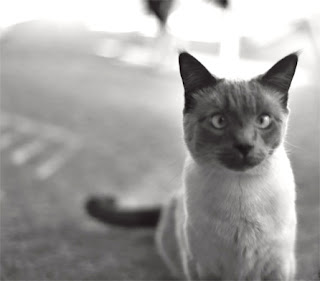
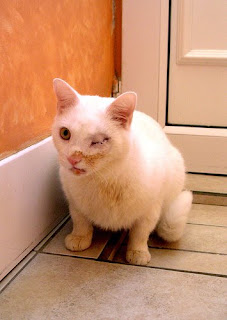

Thanks for commenting Susan.